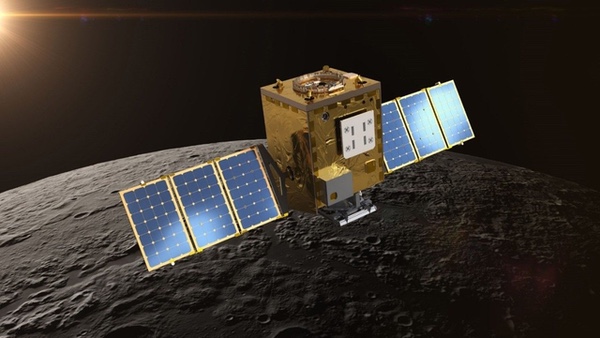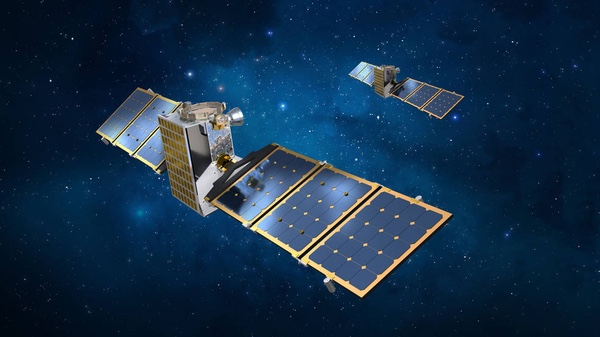The perils of planetary ridesharesby Jeff Foust
|
| “We have no ability to influence the launch dates or the targeting of the launch vehicle, and that arises from our status as a rideshare,” Scheeres said. |
The latest mission to suffer those problems is Janus, a NASA-funded smallsat mission intended to study binary asteroids. Twin smallsats were to launch in August as secondary payloads on the Falcon Heavy carrying the much larger Psyche mission. The Janus smallsats, after performing a series of Earth flybys, would head to two different binary asteroids, 1996 FG3 and 1991 VH.
However, in late May NASA announced that Psyche would not launch in early August as originally planned because of delays testing the spacecraft’s flight control software. Instead, the launch would shift to a backup window that opened September 20 and would run through October 11, one that would have no major effect on the Psyche mission itself.
It did, though, affect Janus. Dan Scheeres of the University of Colorado, principal investigator for Janus, said at a meeting of NASA’s Small Bodies Assessment Group (SBAG) June 8 that the later launch would mean the Janus smallsats would not be able to perform their Earth flybys required to reach their destinations, with one exception: if Psyche launched between October 7 and 10, the spacecraft could still reach one of its original targets, 1996 FG3.
But he acknowledged that it was unlikely that NASA would delay the Psyche launch to the end of the window just to satisfy Janus. “We have no ability to influence the launch dates or the targeting of the launch vehicle, and that arises from our status as a rideshare,” he said.
He said the mission team was looking at other asteroids that Janus could fly by that, while not necessarily binary asteroids, could still provide useful data. One challenge was some of the potential targets violate current mission constraints such as flyby speed or communications data rate, issues he suggested could be accommodated with some effort.
However, on June 24 the situation went from bad to worse for Janus. NASA announced that day that Psyche would not launch at all this year after project officials concluded that the spacecraft’s software could not be completely tested in time to make a launch in that September-October launch window. The agency said both delays in the software itself as well as a testbed for that software—a mix of hardware and software designed to emulate the spacecraft—meant it would not be ready in time.
NASA has not committed to a new launch date for Psyche, electing first to start an independent review of the mission that will provide the agency with recommendations on how to proceed, or even whether to proceed. (With project officials saying they have resolved the problems with the testbed, it seems likely the nearly billion-dollar mission will proceed, but at some additional cost.) The next launch opportunity is July 2023, which would get Psyche to its destination, the metallic asteroid of the same name, in the late 2020s.
Whether Janus will still be around for the ride, and if so, where it will go, remains uncertain. Lori Glaze, director of NASA’s planetary science division, told reporters the top priority was figuring out the plan for Psyche. “Once we know that, we will be able to think a little more completely about what the path forward for Janus will look like,” she said.
| Lunar Trailblazer, which previously had to wait until 2025 for its rideshare launch, could now fly as soon as mid-2023. |
NASA selected Janus in 2019 as one of three missions in its Small Innovative Missions for Planetary Exploration (SIMPLEx) program of small planetary science missions. Each mission was capped at $55 million but also 180 kilograms in mass to maximize rideshare opportunities. (These were not the first SIMPLEx missions, as NASA earlier funded two cubesats under the program. One, LunaH-Map, will launch to the Moon on the Artemis 1 SLS launch later this year. The other, Q-PACE, launched to Earth orbit on Virgin Orbit’s LauncherOne last January to study particle aggregation in microgravity, but was never heard from after launch.)
The agency originally selected the three as finalists but decided to ultimately pursue all three. In addition to Janus, the Escape and Plasma Acceleration and Dynamics Explorers (EscaPADE) mission would study the interaction of the solar wind with the Martian atmosphere, while Lunar Trailblazer would go into orbit around the Moon to map water ice deposits. NASA’s heliophysics division provided funding for EscaPADE while the lunar exploration program would support Lunar Trailblazer.
All three, though, ran into problems with their rideshare launch plans. EscaPADE was originally set to launch with Psyche as well, being dropped off at Mars during Psyche’s flyby of the planet en route to the asteroid belt. However, when NASA elected to launch Psyche on a Falcon Heavy, rather than a Falcon 9 as originally projected, it changed the trajectory of the mission enough that NASA deemed it no longer viable to include EscaPADE on the Psyche mission. The agency put EscaPADE on hold.
The mission, though, found new life last year when the Space Sciences Laboratory of the University of California Berkeley announced a contract with Rocket Lab. The company would provide more capable spacecraft buses for the two EscaPADE spacecraft while remaining within the mission’s cost cap. NASA approved that plan, allowing EscaPADE to proceed for a launch in 2024, although the agency has not announced how it plans to launch the smallsats.
 Lunar Trailblazer, which will be ready for launch by early 2023, will now fly as a rideshare on a CLPS mission launching later that year rather than waiting until 2025 for its original launch. (credit: Lockheed Martin) |
Lunar Trailblazer faced a different problem. Early last year, it was clear the spacecraft would be ready for launch as soon as late 2022. However, NASA has manifested the spacecraft as a secondary payload on the agency’s Interstellar Mapping and Acceleration Probe (IMAP) mission. That launch, once projected for 2024, had slipped to early 2025. Lunar science and exploration advocates had pushed NASA to find an earlier ride for Lunar Trailblazer, in part because its data could support later Artemis missions.
Fortunately, Lunar Trailblazer got some good news last month. At a June 21 meeting of the Planetary Science Advisory Committee, Glaze announced that Lunar Trailblazer will instead fly as a secondary payload on the Falcon 9 launching the second lunar lander for Intuitive Machines, called IM-2. That mission, carrying payloads for NASA’s Commercial Lunar Payload Services (CLPS) program, is tentatively scheduled for launch in mid-2023, pending the outcome of the IM-1 mission projected to launch no earlier than the end of this year.
“We have removed Lunar Trailblazer from the IMAP manifest so that it can fly sooner,” Glaze said at the committee meeting. She said NASA’s Lunar Discovery and Exploration Program would cover the “additional cost” of flying Lunar Trailblazer on IM-2 but did not disclose what that cost was.
Lunar Trailblazer, at least, had plenty of launch opportunities thanks to the CLPS program and other cislunar missions. It’s less obvious how EscaPADE will get to Mars, or how Janus will find a new way to reach suitable asteroids.
| “This really is an entirely new system for deep space exploration at just a ridiculously low cost,” Beck said of Lunar Photon. |
One solution is to go back to dedicated launches, but with a low-cost twist. Less than four days after NASA announced the delay to Psyche and Janus, a Rocket Lab Electron lifted off from New Zealand. Its payload: a NASA-funded lunar cubesat called CAPSTONE, attached to a kick stage called Lunar Photon (see “Cubesats to the Moon”, The Space Review, May 31, 2022.) After a series of burns by its HyperCurie engine, Lunar Photon deployed CAPSTONE on a lunar trajectory July 4.
For Rocket Lab, the launch demonstrated that the combination of Electron and Lunar Photon could enable missions not just to the Moon but elsewhere in the inner solar system. “We’ve built really impressive, low-cost access to not only the moon but to asteroids and other planets in our solar system,” Rocket Lab CEO Peter Beck said on his company’s webcast of CAPSTONE’s deployment. “This marks the beginning of a new scientific era where, for some tens of millions of dollars, you can go to the Moon or you can go to an asteroid or you can go to Mars or Venus.”
Beck said in an earlier interview the company was planning to use the same system for a privately funded Venus probe mission Rocket Lab is working on, replacing the cubesat with an atmospheric entry probe. “This really is an entirely new system for deep space exploration at just a ridiculously low cost,” he said.
That specific approach, though, has limitations: while it may work for lunar cubesats and small atmospheric entry probes, larger spacecraft, like the SIMPLEx smallsats, are likely too big to make use of it. However, there are somewhat larger, but still inexpensive, small launch vehicles available that could enable dedicated planetary science missions.
In January, NASA selected a dozen launch companies for its Venture-Class Acquisition of Dedicated and Rideshare (VADR) program for low-cost smallsat launches. It includes a range of companies, from small launch vehicle developers yet to perform their first launches to established companies like SpaceX and United Launch Alliance. On July 1, NASA announced in a procurement filing it was in talks to add Firefly Aerospace to the VADR contract.
Vehicle like Firefly’s Alpha as well ABL Space System’s RS1 and Relativity’s Terran 1, are significantly larger than Electron and might provide a better fit for SIMPLEx-class planetary missions at only a modest additional cost (NASA paid about $10 million for the Electron launch of CAPSTONE.) So far, none of those vehicles has performed a successful launch. NASA, though, is willing to accept more risk for SIMPLEx and other “Class D” missions.
At the Planetary Science Advisory Committee last month, Joan Salute, program executive in NASA’s planetary science division, said the agency was starting to consider vehicles on the VADR contract as alternatives to rideshare launch opportunities for SIMPLEx missions. “We have not made specific plans to make use of that,” she said of VADR, “but that is another avenue opening up.”
For now, rideshare missions like Janus will have to wait. At the SBAG meeting last month, Scheeres said there was no thought to moving off the Psyche launch after its delay caused Janus to miss its original destinations. ““That’s not going to get us any closer to our original target binary asteroids,” he said, “unless someone’s willing to spring for an independent launch for us, and I haven’t found any takers for that.” Not yet, at least.
Note: we are using a new commenting system, which may require you to create a new account.
